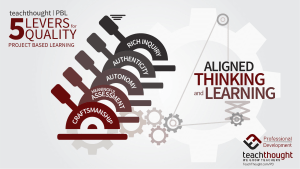
How To Integrate Project-Based Learning In Any Content Area
contributed by Shann Griffith
Ed note: Though this post written with elementary aged students in mind, it applies to all content areas in concept, thus the more general title and the in-text mention of elementary school.
The elementary years are critical for grounding a student’s understanding of key concepts, across subject areas, to tangible processes and results. To help students grasp the intersections between what they learn in school to the world around them, project-based learning is a handy tool.
By weaving content and vocabulary into a real-world, project-based learning unit, teachers in all subject areas can teach to standards while molding students into critical thinkers, entrepreneurs and problem solvers.
I’ll walk through how I transformed a 3rd grade Social Studies unit on Personal Finance into a STEAM-rich unit to illustrate how project-based learning can transcend subject areas.
1. Make it realistic, fun, and engaging.
Provide an avenue for students to visualize their idea as a solution to a real-world problem.
Simulating business operations and production models can provide students a tangible goal to work toward. For example, my students assigned to the role of a ‘developer’ created and developed a product or services to sell in a real Market Day Bazaar. The driving question was, “What would be the best product for me to make to sell at the bazaar considering supply and demand and other economic principles?”
2. Learning is social. Provide opportunities for collaboration.
Like the workplace, decisions require a process of discussion and collaboration. To decide what students would make for the Market Day Bazaar, developers posted their idea(s) on a discussion board along with the price they would charge to see if there is a demand.
Classmates responded honestly to as many proposals as possible. Developers made decisions based on the answers of their peers and engaged in critical thinking and collaboration to reach a decision.
3. Roll in standards from several different disciplines to make project-based learning time efficient.
Here are the many cross-disciplinary standards students were exposed to in the Market Day Bazaar project.
- Social Studies: In this project, students applied the following personal finance vocabulary terms which are part of their standards and content: goods/services/interdependence/trade/consumer/producer/currency/entrepreneur/spending/saving/supply/demand/costs/ benefits/budgeting.
- Math: To determine if a product is cost-effective to produce, students practiced the following skills: Add and subtract fluently/fluently multiply and divide/make sense of problems and persevere in solving them/construct viable arguments and critique the reasoning of them/use appropriate tools strategically/attend to precision.
- Language Arts/Technology: Write a commercial for your product, film it and broadcast it on the School News Show, or on your class website.
- Technology: If there is a high demand for your product or service, produce a “how-to” video on how to make your product or how to provide that service.
- Art: The neater the design and/or area at the Market Bazaar the better chance the developer has of selling his goods/services. Allow time for revision and reworking.
4. Help students see their model.
Teach students to critically analyze data to determine if, or how, revisions would improve their model. Decisions must be based upon the information they collected, and the calculations they made. Assure students that it is acceptable to scrap a product and start over if it is too expensive to make, or if there is no demand for that product, or if there are too many people selling the same thing.
5. Recognize that interdisciplinary, STEM rich project-based learning units are gifts you give to your students.
Teaching students how to think critically and analyze the evidence will help them become excellent problem solvers, which will lead to fewer mistakes, and richer, more empowered lives. STEM and PBL can sometimes be loud and messy, but the pay-off is well worth the price.
Shann Griffith is a K-5 media specialist at Head Elementary in Lilburn, Georgia, and leader of Wonder Workshop’s Wonder League Robotics Competition winning team, the Unconditionals.
Looking to grow PBL at your school? Check TeachThought PD PBL Workshops.

